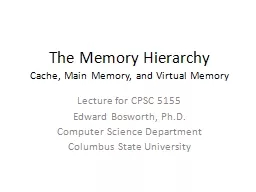PPT-Memory technology and exam review
Author : pamella-moone | Published Date : 2016-07-17
EECS 373 Group projects Meetings on Friday Should have signed up If someone is going to be missing let us know Project ideas look fine Safety is going to be a worry
Presentation Embed Code
Download Presentation
Download Presentation The PPT/PDF document "Memory technology and exam review" is the property of its rightful owner. Permission is granted to download and print the materials on this website for personal, non-commercial use only, and to display it on your personal computer provided you do not modify the materials and that you retain all copyright notices contained in the materials. By downloading content from our website, you accept the terms of this agreement.
Memory technology and exam review: Transcript
Download Rules Of Document
"Memory technology and exam review"The content belongs to its owner. You may download and print it for personal use, without modification, and keep all copyright notices. By downloading, you agree to these terms.
Related Documents














